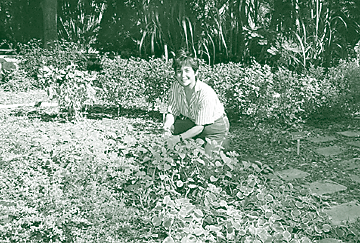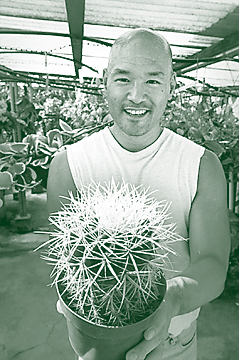



File photos
You don't need a large herb garden, like the one tended
at Foster Garden by Maureen Crotty, but try growing herbs
you use in your cooking. Or try something else new, like
the white spiked cactus held by Mike Miyashiro.
Happy New Year. It's time for a few New Year's Resolutions for the gardener. No, not the one about starting a compost pile. Certainly, everybody ought to compost garden waste, but if you haven't got one by now, it will take more than New Years resolve to bring it about. Garden ideas to cultivate
Instead, let's make it easier. Here are a few ideas to make you and your garden grow:
1. Enjoy your garden.
Figure out just how much time and effort you are willing to put into it and scale it to those limits.
Everybody's yard doesn't have to look like the cover of Garden Design. If you've tried roses or gardenias and it's a battle between you and the bugs and the blight, take them out and plant something you know will grow in your area.
How do you know? Take a slow walk around the block and see what thrives in the neighbors' yards and what looks pale and peaked. Pretty much the same thing will happen in your garden because you share the same soil and climate. Oahu is a series of micro-climates and what will grow in Ewa almost surely won't grow as well in Nuuanu.
2. Try something new.
Join the Cactus and Succulent Society and learn how to grow all those prickly plants with their exotic flowers. Buy a few orchid plants and get involved with one of the most habit-forming hobbies in horticulture. Take out a book on water gardens from the library and grow lotus and water lilies on your lanai. Poke around the garden shops and find a couple of plants that have possibilities as bonsai. Small leaves, small flowers are the rule, and learn how to prune and wire them.

3. Share your garden.Learn how to air-layer your plants, how to propagate new plants from seeds and how to cultivate seedlings. Start these young plants in pots and give them as gifts to your hostess or when visiting a friend in the hospital.
Give flowering plants as gifts and grow plants to donate to school or church benefits.
4. Take care of your garden tools.
Don't leave them out in the rain, clean the dirt off of them after you've used them and oil metal tools to keep them from rusting. Keep pruners, spades and hoes sharpened. Coil hoses so they don't kink or get run over by your car.
Buy the best tools you can -- steel tools should be labeled "heat-treated" or "forged," and they should have a solid feel to them. Wood handles are more durable than metal or plastic handles.
Buy only what you need. Catalogs are filled with gadgetry, much of which is fun but not essential.
5. Learn to recognize plant problems early, so that they can be treated and the plant saved.
Are leaves turning pale or yellow? The plant is getting too much sun or too much water. Is there a silver stippling on the leaves? It has spider mites. The plant won't flower? It is receiving too little light, it needs lower temperatures or a dry period, or you are using a fertilizer with too high a level of nitrogen, the first number in the three-number formula on the bag.
6. Learn to cut your losses. You are growing plants, not adopting them. If they aren't growing well with about as much care as you intend to devote to them, dig them up and throw them out.
This is particularly true of potted plants. If it has gotten too big or spindly or just looks out of sorts, put it on the compost pile if you have one, or in the rubbish if you haven't.
7. Plant some herbs and learn to use them.
Read your cookbook first, and grow the ones you otherwise buy dried in bottles. Grow a little of a lot of different herbs because you never need much at any one time.
Most herbs are small, delicate plants that grow best in medium-rich soil and at least 6 hours of sunlight every day. Insects rarely bother them because the herbs themselves are insect repellent.
8. Learn how much is enough. Over-watering kills, and so does over-fertilizing.
Remember that fertilizer manufactures aren't selling plants, they're selling fertilizer, and in many cases you are better off using less than the amount recommended on the sack.
On our island, water is a finite resource, and we can't afford to waste it. Water your garden specifically so that you don't drown the plants that need less irrigation, and watering the driveway only promotes weeds.
That's a good beginning, and work on only those resolutions that affect your garden. Maybe the compost pile would be a nice thought for next year, for the millennium. Have a happy, green New Year.
Gardening Calendar in Do It Electric!
Send queries along with name and phone number to:
Evergreen by Lois Taylor, Honolulu Star-Bulletin, P.O. Box 3080, Honolulu 96802.
Or send e-mail to features@starbulletin.com.
Please be sure to include a phone number.
Evergreen by Lois Taylor is a regular Friday feature of the
Honolulu Star-Bulletin. © 1998 All rights reserved.